5.20 SP2 Maytas ESFA Release Notes
Note regarding submissions
We would like to remind providers to create a submission early and check for any errors using reports from the appropriate software (i.e. the FIS or LLWR-Inform). Welsh providers should also remember to download their ULI file. After submission to the ESFA or DfES, providers should check that data has submitted correctly using the available reports. Providers should check that all their expected starts and completions are submitted correctly, and that start and outcome payments correctly match the PFR or ACE funding reports.
Our support desk gets extremely busy in the days prior to the submission deadlines, and although we try and prioritise submission-related queries, we cannot guarantee assistance if queries are sent late. If you do encounter any issues, please ensure that you contact Maytas Support as soon as possible, as we can only rectify issues of which we are aware. We also recommend checking Maytas Communities regularly for information on any known issues and solutions. Tribal cannot be held responsible for any issues caused by your failure to comply with this advice.
Technical specification
The latest Maytas and e-track technical specification can be found here.
Once the upgrade has been completed, the version number should be checked to ensure it has been successful.
- Start Maytas and go to Support on the toolbar.
- Click About.
- The version numbers should read 181.20 / 5.20.7620.1. If you have any other version, please ensure you have followed the upgrade instructions correctly. If you require assistance, please contact Maytas Support.
It is the responsibility of customers to ensure that users carry out any required user acceptance testing and sign off on the upgrade.
Complete the Upgrade
Features Added in the Upgrade
These are the main updates in the upgrade:
- Invoke workflows from Maytas
- SITS integration
- Smart Assessor integration updates.
- Fixes to a number of issues
Import Funding Information
The process for importing the required funding information into Maytas is as follows:
- The old FIS 2018/19 application should be used to import data sets for 2018/19 and earlier if it has not previously been imported.
- The LARS for 2020/21 should be imported.
- Postcode data for 2020/21 should be imported.
- Once all data has been imported, ensure that the funding cache is refreshed (either on a database schedule or a manual update out of working hours).
Re-Import the FIS Data Sets
If the 2018/19 data sets were imported in 5.19 or a previous version of 5.20, this step can be skipped and you should proceed to importing the LARS.
If the FIS data sets for 2018/19 were not imported in the 5.19 or previous 5.20 release, it is essential that they are imported into Maytas one final time for use by the funding cache. This should be done by importing the relevant information directly from the Data Service’s Funding Information System (FIS). To do this, you must have the FIS installed and correctly configured (please refer to the Data Service’s instructions for setting up the FIS).
Please ensure you have the latest version of the 2018/19 FIS application with the latest components installed.
Once the FIS is installed and configured, the information can be imported as follows:
- Perform a sync in Maytas 5, then restart Maytas 5.
-
Go to Exports | Uploads | Upload FIS Data Sets.
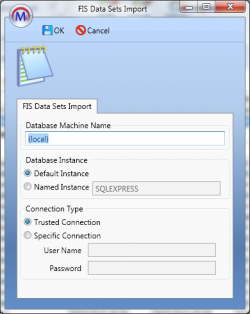
- There are three items to configure:
- Database Machine Name – If the FIS is installed on the same machine that you are using for Maytas 5, this can be left as (local). Otherwise, enter the machine name of the SQL server where the FIS database is held.
Database Instance – If the SQL server holding the FIS database has a named instance (e.g. MACHINENAME\INSTANCENAME), select Named Instance and enter the instance name. Otherwise leave this as Default Instance.
If you have no named instance and Default Instance does not work, you may need to select Named Instance and leave the instance name blank.
- Connection Type – This is the login for the SQL server holding the FIS database. Trusted Connection will use Windows authentication. If you wish to specify the login details, select Specific Connection and enter the credentials.
- Click OK. The FIS data will now be imported.
- If you have an Adult Skills budget contract and a transition factor, this must be entered on the contract:
- Go to Management on the toolbar and click Contracts on the ribbon.
- Select the relevant contractor, then select the Adult Skills contract on the right.
- Click the
 button.
button. - Go to the Uplifts tab.
- Enter the ASB Transition Factor and click OK.
- Click Apply to save the change.
Import LARS
The LARS for 2020/21 should be imported as follows:
- Download the LARS MDB file for 2020/21. At the time of this release, the latest version is the LARS MDB version 7.
- In Maytas, go to Exports on the toolbar.
- On the ILR Tools panel of the ribbon, go to Uploads | Upload Funding Information | Upload LARS (Version 7).
- Browse to and select the downloaded LARS file and click Open.
- The file will now be imported. Click OK on the message which appears.
Progress on the import can be checked by going to Home | Server Tasks | Server Jobs. Typically it will take several minutes.
Import Postcode File
- Obtain the postcode uplift factors file - Download the zip file under 2020 to 2021 uplift factors by postcode and LLSOA: CSV files.
- In Maytas, go to Exports on the toolbar.
- On the ILR Tools panel of the ribbon, go to Uploads | Postcode Uploads | Upload Post Code Data (2020/21).
- Browse to and select the postcode uplifts zip file and click Open.
- The file will now be imported. Click OK on the message which appears.
Progress on the import can be checked by going to Home | Server Tasks | Server Jobs. Typically this will take several minutes.
Devolved AEB postcode data is also available for importing, but it is not currently used in Maytas and so there is no need to import it. Future upgrades may require it to be imported, depending on whether the data is used in the funding calculations.
Large employer factor data sets do not need to be imported for 2020/21. LEF data for 2018/19 and earlier is included in the FIS import.
Note on the Funding Cache
By default, the funding cache will update overnight so that funding information in Maytas uses the newly-imported FIS and postcode information. Please check with your system administrator if you are unsure if or when the funding cache is updated on your system. You can also manually set the funding cache to update by going to Management | Profiles and clicking the Funding Cache button, though please be aware that this may take a long time and may use a large amount of system resources, which could affect performance for other users on the system.
Maytas 5 Version 5.20.7620.1 Release Notes
Invoke Workflows
Workflows created in e-track can now be invoked from Maytas. This requires a permission to be set:
- Go to Tools | Edit Permissions.
- Select the user or group which requires permission.
- Go to the Commands tab.
- Expand the Workflows Integration section.
- Tick the box next to the Invoke Workflows permission and ensure the toggle box is set to Visible.
- Click Apply.
- Restart Maytas for the change to take effect.
Invoking a workflow for a learner
- Open a learner record.
-
On the Actions panel of the ribbon, go to Tools | Invoke Workflow.
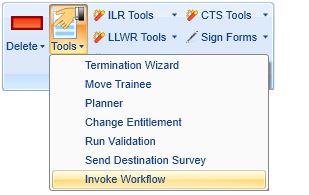
-
The Invoke Workflow screen will appear. Select the workflow to invoke from the dropdown box and select any options on forms as required.
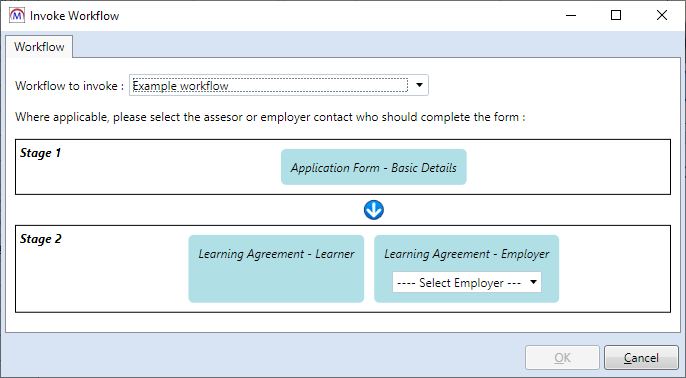
- Click OK. A message will appear confirming that the workflow has successfully been added. Click OK to close the message.
- Click Apply to save the changes and invoke the workflow.
Invoking a workflow for a visit
Visit workflows can be invoked from the Diary tab on learner, assessor and employer records. However, a visit workflow can only be invoked on a learner if the learner is assigned to the selected visit.
Also please be aware that if a visit workflow is invoked on a learner and that visit has multiple learners assigned to it, the workflow will only be invoked against the first learner assigned to the visit.
- Open a learner, assessor or employer record and go to the Diary tab.
- Open the visit you want to invoke a workflow for.
- Click the
 button at the top of the visit window.
button at the top of the visit window. -
The Invoke Workflow screen will appear. Select the workflow to invoke from the dropdown box and select any options on forms as required.

- Click OK. A message will appear confirming that the workflow has successfully been added. Click OK to close the message.
- Click OK to close the visit, then click Apply to save the changes and invoke the workflow.
SITS Integration
Maytas now integrates with SITS so that ILR learners can be imported and updated in Maytas from the SITS database.
The SITS Integration requires a licence. Please contact your account manager for information on purchasing this module.
Import Licence
Once you have received your licence file, it must be imported as follows:
- Open Maytas 5 Server Manager.
- Select the appropriate data service and click Licenses.
- Click the
 button.
button. - Browse to and select the licence file and click Open.
- Click Close.
- Click Stop on the data service. Once it has stopped, click Start to restart it.
Permissions
To set permissions in Maytas for the SITS Integration module:
- Go to Tools | Edit Permissions.
- Select the user or group which requires permission.
- On the Modules tab, set SITS Integration to Visible.
- Go to the Commands tab.
- Expand the SITS Integration section and set the Sync with SITS permission to Visible.
- Restart Maytas for the changes to take effect.
Configuration
Several configuration options must be set for the SITS integration to work:
- Click the M5 button at the top left and select Options.
- Select SITS Integration on the left (under the Maytas 5 header).
-
Complete the configs as follows:
Configuration option What to enter Default centre ID to use for new learner records created from SITS imports The default centre ID to be used for new learner records that are imported from SITS Client Id for IDS Provided by Tribal Client secret IDS url Provided by Tribal Default contractor ID to use for new learner records created from SITS imports The default contractor ID to be used for new learner records that are imported from SITS SITS IDS password Provided by Tribal SITS IDS username Provided by Tribal SITS IDS url Provided by Tribal Default scheme ID to use for new learner records created from SITS imports The default scheme ID to be used for new learner records that are imported from SITS SITS API url Provided by Tribal - Click OK.
- Restart Maytas for the changes to take effect.
Using the SITS Import
The SITS import tool allows you to synchronise ILR learners between SITS and Maytas, so that any ILR learners in SITS that do not exist in Maytas (matched on learner reference number) are imported into Maytas. Additionally, any learners that do match between the two systems are updated so that the data in Maytas matches the data in SITS.
The SITS integration only imports learners from SITS to Maytas. Learner data is not sent from Maytas to SITS.
The fields which are mapped between Maytas and SITS can be found in the M32$_ILRDEFINITION table.
The SITS import tool can be found by going to Management on the toolbar and clicking the Synchronise button on the SITS panel of the ribbon.
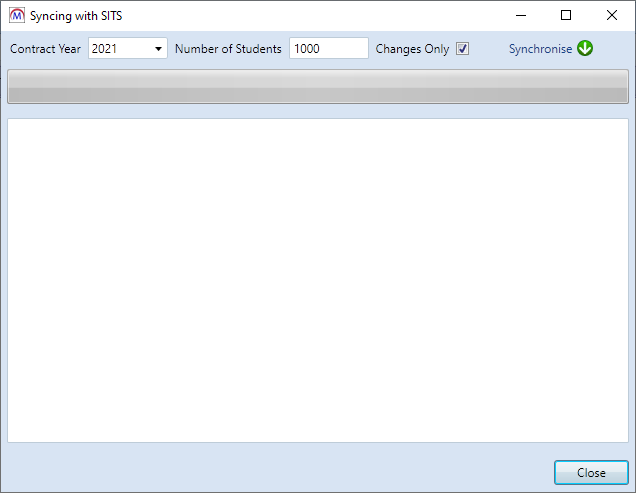
Select the Contract Year from the dropdown box at the top and click Synchronise.
The Number of Students and Changes Only options should be left as default for the time being, as there is SITS development still in progress to implement these parameters fully in SITS. Changing them may have unexpected results.
The sync will now begin. For the first few minutes, you will see a note which says Getting Student IDs, which is getting a list from SITS of the learner records which will be downloaded. Once this has completed, you will see a note which says Updating Learners, and the progress bar will begin to update.
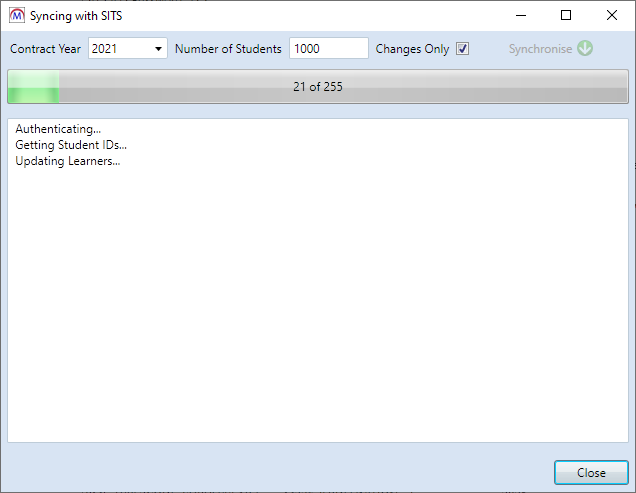
It is safe to click the Close button at any point and continue using Maytas, as the import process will continue running in the background. You can go back to Management | Synchronise to view the progress.
When the import has completed, the message Finished will appear in the log area of the window.
If any issues are encountered during the import, these will be listed in the log. All errors are logged in the SITS_IMPORTLOG table along with any additional information which may help to identify the cause of the issue.
Smart Assessor Integration - Additional Fields
The Maytas integration with Smart Assessor now includes several additional fields which are mapped between the two systems. The fields are included on updated versions of the Smart Assessor tabs, which are imported automatically in the upgrade but must be re-published:
- Go to Tools on the toolbar and click New / Load on the Screens panel of the ribbon.
- Select Trainee on the left and double-click Smart Assessor on the right.
- Tick the Published tab on the left.
- Click Apply.
- Repeat the above steps for the Smart Assessor tabs in the Employer and Personnel entities.
- Go to Home on the toolbar and click Sync.
New Learner Mappings
These fields can be found on the updated Smart Assessor tab for learners in Maytas.
| Field Name | Name in Smart Assessor | Maytas Table and Field |
|---|---|---|
| Initial Assessment - Numeracy | InitialAssessmentNumeracy | TRAINEEPOT.INITIALASSESSMENTNUMERACY |
| Initial Assessment - Literacy | InitialAssessmentLiteracy | TRAINEEPOT.INITIALASSESSMENTLITERACY |
| Initial Assessment - ICT | InitialAssessmentICT | TRAINEEPOT.INITIALASSESSMENTICT |
| Domicile | Domicile | TRAINEEPOT2.ILR_DOMICILE |
New Employer Mappings
These fields can be found on the updated Smart Assessor tab for employers in Maytas.
| Field Name | Name in Smart Assessor | Maytas Table and Field |
|---|---|---|
| Health & Safety Assessment Date | HandSassessmentdate | EMPLOYER.HANDSASSESSMENTDATE |
| Health & Safety Assessment Renewal Date | HandSassessmentdaterenewal | EMPLOYER.HANDSASSESSMENTRENEWALDATE |
Screen Designer - Hide Grid Buttons
New options to show or hide grid buttons are now available when configuring grids in the Screen Designer.
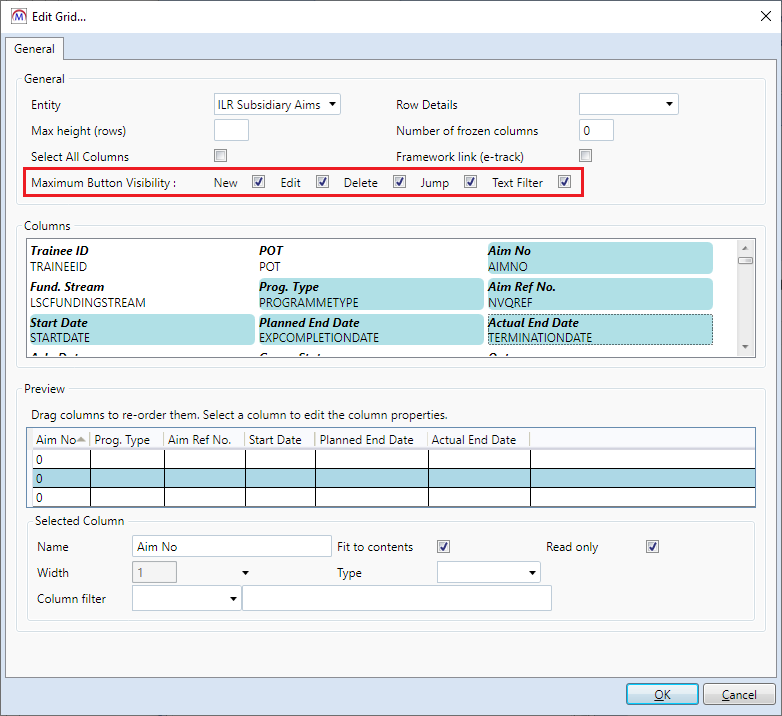
Each button can be ticked or un-ticked to enable or disable it. Click OK, then click Apply once changes have been made.

The example grids above show all buttons enabled (top) and disabled (bottom). Note that with all buttons disabled, the refresh and column filter buttons remain.